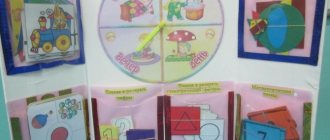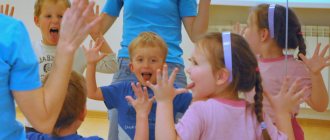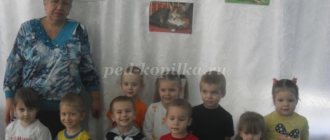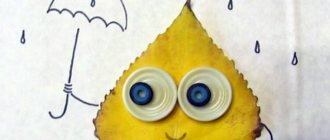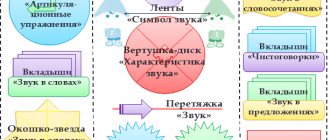Lapbook “Pets”
Prokofieva Irina Olegovna teacher, MBDOU kindergarten No. 6 combined type, Belgorod
The material was sent to the ongoing professional competition for teachers of preschool educational institutions “Lapbook - a fun development technology.”
Information sheet Lapbook “Pets”
Relevance of the problem:
- The laptop is a new learning tool.
Advertising message
With the introduction of the Federal State Educational Standard, every preschool teacher is in constant search for new forms of organizing educational activities. A laptop is a wonderful find for a teacher. This type of benefit appeared relatively recently in our country, but its popularity is only growing.
Literally translated, the term “lapbook” is “a book on your lap.” That is, it is a thematic folder with many pockets and windows in which material on a specific topic is collected. It is recommended to do this benefit together with children and parents. The value of such a folder for each child increases.
And parents have the opportunity to spend even more time with their child.
Problem:
A significant decrease in the cognitive activity of children; the need for independent knowledge of the surrounding reality is not sufficiently formed.
I present to your attention a lapbook on the topic “Pets”.
Goal: to arouse interest in the topic being studied, increase curiosity, attract children to individual and joint activities under the guidance of an adult.
Tasks:
- Educational: expand and consolidate children’s knowledge about domestic animals and their cubs (what they eat, where they live, what benefits they bring, distinguish by external features and structure);
- Developmental: develop gross motor skills, coordination, visual and auditory memory; develop coherent speech; develop children's verbal and logical thinking;
- Educational: cultivate a love for pets.
Age: For children 5-6 years old.
A laptop for preschoolers is an amazing and very useful guide that has gained popularity in our country relatively recently. This manual helps you quickly and effectively learn new information and consolidate what you have learned in an entertaining and playful way. The laptop is multifunctional; it consists of several games that serve a specific purpose. It’s especially nice to make a lapbook with your own hands.
A laptop can be used in educational activities, as well as in special moments, for joint and individual activities. It is a thematic interactive folder with various pockets and curly envelopes.
The design of the lapbook includes: a rotating circle, pockets, cut and whole plot pictures, flat images of animals, a “folding” book.
Lapbook includes:
- Cutting pictures: “Find the difference”
Goal: continue to develop the ability to compare objects, establish their similarities and differences (how these objects are similar and how they differ, etc.).
- Pocket with riddles: “Riddles about animals”
Goal: to develop cognitive interest, auditory perception and thinking of children.
- Pocket: “Coloring books.”
Goal: development of visual perception, attention, logical thinking.
- Rotating circle: “Who eats what?”
Goal: consolidate knowledge on topics, create conditions for activating the child’s vocabulary on these topics, develop the ability to analyze, consolidate the ability to distinguish and name animals, and develop fine motor skills.
- D/i “Who lives where?”
Goal: development of children's visual perception, attention, logical thinking.
- Pocket “Story pictures”
Goal: to form in children an idea of a holistic image, to teach children to compose descriptive stories about pets, using a plan.
- Pocket: “Whose baby?”
Goal: to consolidate children's knowledge of naming domestic animals and their babies.
- Envelopes: “What benefits do they bring?”
Goal: To enrich the vocabulary on the topic, to introduce words into the children’s dictionary that will be new to them.
- Pocket: “Cut pictures”
Goal: to introduce children to different parts of the animal body.
- Pocket: “Learn to count”
Goal: to develop the grammatical structure of speech, to learn to coordinate nouns with numerals.
This lapbook is a great way to review and consolidate the material you have covered. At any convenient time, the child simply opens the laptop and happily repeats what he has learned, looking at the pictures and completing tasks.
As a result, children will know the names of domestic animals and their babies; they learn that a person cares for domestic animals (feeds, waters, treats, washes, protects, grazes); They will also know what pets eat and what benefits pets bring to people; children will use the names of domestic animals and their cubs in speech, solve riddles, and will love and care for their pets.
Lapbook for working with young children “Pets”
Alla Stalchuk
Lapbook for working with young children “Pets”
This lapbook is intended for working with young children (2-3 years old).
Goal: to introduce and examine domestic animals with children, name them, paying attention to their characteristic features: “the cow is big, it has horns, hooves, a long tail with a tassel,” etc.; reinforce with children the signs of differences and similarities between domestic animals: “a cat and a dog have a mustache, but no hooves or horns.”
Objectives: clarify the names of animals and their cubs; develop the eye and visual attention; fine motor skills training; development of memory and auditory attention; consolidation of coherent speech; clarify the names of body parts; development of logical thinking.
A laptop can be used in educational activities, as well as during routine moments, for joint and individual activities. It is a thematic interactive folder with various pockets and envelopes. The laptop has pockets of a convenient shape, small size, durable, and convenient for use by children. The child can open the pockets independently without much effort.
All cards and pictures are laminated, which will allow you to use the laptop for a long time. The laptop consists of four parts.
List of tasks presented in the laptop:
The first block (the most voluminous):
1. Pictures of “pets”.
Goal: teach children to name pets.
2. Poems on the lexical topic “Pets”.
Goal: to develop general speech skills, work on intonation expressiveness of speech, and develop children’s memory.
3. Didactic game “Halves Pictures”.
Goal: to develop in children the ability to compose a whole image from two parts.
4. Didactic game “Mom and Cub”.
Goal: to teach children to distinguish between adult animals and their babies; develop the child’s thinking, speech, and vocabulary.
Second block (left side):
1. Didactic game “Who says what.”
Goal: to develop children's cognitive interest, auditory perception and thinking in children.
2. Didactic game “Me and my shadow.”
Goal: development of children's visual perception, attention, logical thinking.
Third block (right side):
1. Riddles about pets.
Goal: to develop oral speech in children and enrich their vocabulary.
2. Didactic game “Find my tail.”
Goal: to develop children’s knowledge about the parts of an animal’s body, to teach them how to select the right tail for a particular animal.
Fourth block (folding part):
1. Finger games on the theme “Pets”.
Goal: development of fine movements of the fingers.
2. Coloring pages.
Goal: to instill a desire to draw; development of fine motor skills of the hands; fostering perseverance, independence, and accuracy.
Pets and birds. Lapbook – Lapbook “Wild and Domestic Animals”
Publication “Lapbook “Wild and Domestic...”
Lapbook “Wild and Domestic Animals” This lapbook is made for preschoolers of all age categories and is aimed at developing the cognitive processes of preschoolers. Working with a lapbook meets the main thesis of organizing partnership activities between an adult and children. -involvement...
Image library "MAAM-pictures"
Lapbook “Pets”
Lapbook “Pets” A lapbook (interactive folder) is a homemade cardboard folder with pockets, windows, and movable parts that can be taken out, folded and rearranged at your discretion. A laptop is made together with children on a specific topic. He…
Lapbook “Pets” in the second junior group
Lapbook "Pets". Didactic material that helps enrich children's knowledge about domestic animals. Helps you learn new material and reinforce what you have learned in a playful way. At any time, the child simply opens the laptop and happily repeats with the help of an adult...
Lapbook “Pets”
Goal: to arouse interest in the topic being studied, increase curiosity, attract children to individual and joint activities under the guidance of an adult. Tasks: - clarify the names of domestic animals and their cubs; - develop fine motor skills; - develop memory and auditory...
MAGAZINE Preschooler.RF
Lapbook “In the world of animals”Kersh Larisa Sergeevna, teacher of MBDOU "CRR - d/s "Ryabinushka" , Abakan, Republic of Khakassia
Description: The manual is intended for children of senior preschool age.
Educational objectives:
- creating conditions for enriching children's knowledge about animals
- creating conditions for the formation of ideas about the diversity of the animal world
- creating conditions for the development of each child’s cognitive, creative abilities and independent activity
- creating conditions for the development of speech, imagination, memory
- creating conditions for attracting parents and helping in the further operation and updating of the laptop.
The lapbook “In the Animal World” is a book consisting of 4 pages. On each page there are pockets with tasks or games for children to do independently. The contents of all pockets are constantly replenished and updated.
1. "Guess the Animal"
Based on the first sounds of these words (pictures depicting objects or animals), make up the name of the animal.
2. "Puzzles"
Made in the form of a pocket with pictures and riddles about animals. You can not only read riddles, but also examine the animal. Conditions are created for the development of attention, thinking, and speech.
3. "Crosswords"
Crosswords are compiled either on the topics “Wild Animals” , “Animals of the North”, etc., or on fairy tales “Remember the heroes of the fairy tale “Teremok” , etc.
Crosswords are aimed at consolidating and expanding children's ideas about the diversity of the animal world, fostering love and caring attitude, improving anagram solving skills, expanding children's horizons, developing logical thinking, attention, and memory.
4. Game “Whose house?”
It consists of three houses. There can be several game options:
move the animals shown in the picture into three houses:
according to the syllabic pattern; by the number of syllables in a word (1, 2, 3); by letters found in the animal's name
according to their habitat; by the first letter of the animal's name.
(domestic, wild, northern, etc.)
5. Puzzles
Conditions are created for the development of logical thinking, intelligence, fantasy, and imagination.
6. Hatching.
Shade the animal according to this drawing (with sticks, arcs, zigzags, etc.)
Conditions are created for the development of initial graphic skills through correctional and developmental exercises and tasks that help prepare the hand for writing
7. Origami
Children are given diagrams for the step-by-step collection of an animal; children must independently assemble the animal shown in the diagram from a square.
Conditions are created for the development of children’s abilities to read and draw diagrams, understand and follow instructions;
Conditions are created for the development of creative abilities, spatial-imaginative thinking, and imagination; coordination of fine movements of the fingers.
8. "Color"
There are different options for painting the animal depicted on the piece of paper:
free coloring; coloring by numbers; coloring by letter;
coloring by dots
Where each number, letter or dot corresponds to a specific color.
Children choose the picture they like and paint it according to the proposed method (free, by dots, by numbers, etc.).
Conditions are created for the development of the ability to paint animals, the colors and shapes of animals are fixed; conditions are created for the development of drawing skills and preparing the hand for writing.
9. "Graphic dictation"
According to the proposed scheme, children need to draw an animal in cells.
Conditions are created for the development of fine motor skills and hand coordination, and spatial thinking is formed.
10. "Magic numbers"
Children need to sequentially connect the numbers from 1 to ... to get an image of some animal. A wonderful way to prepare your hand for writing and strengthen counting skills.
In conclusion, I would like to note that this form of work helps to create conditions for supporting children's initiative and creativity in the group. In the process of such creativity, the child becomes not only the creator of his own book, but also a designer, illustrator, and writer of his own stories, riddles, and poems. This exciting form of work creates conditions for the development of the child’s personality, motivation and abilities.
This form of work in child-adult interaction, both together with teachers and family projects, develops more trusting relationships when working with families, increases parental (professional) competence and makes it possible not only to recognize the interests and potential of a preschooler, but also to develop them.
In my opinion, a lapbook is an effective technology for preschool education.
And the laptop is a very mobile system. You can give this folder, so to speak, “for a stay” to another group or even to your child’s home.
Firstly, a lapbook helps a child organize information on a topic of interest at will, and better understand and remember the material.
Secondly, this is a great way to review the material you have covered. At any convenient time, the child simply opens the laptop and happily repeats what he has learned, looking at the book he made with his own hands.
Thirdly, the child independently collects and organizes information.
Fourthly, you can choose tasks that everyone can do (for kids - pockets with cards or animal figures, for example, and for older children - tasks that require the ability to write, etc.)
Well, in the end, it's just interesting.
| Next > |

